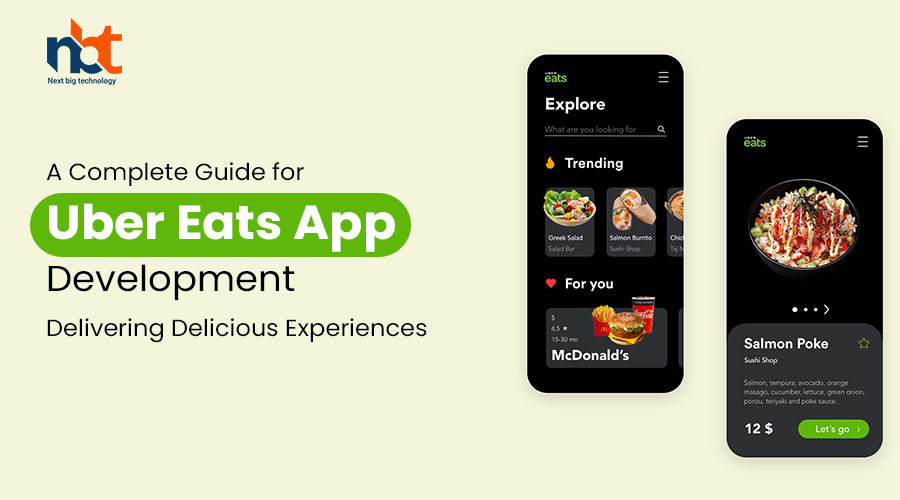Introduction:
Uber Eats has transformed the way people order food, providing a convenient platform for food delivery from a variety of restaurants. With its user-friendly interface and efficient delivery system, Uber Eats has become a popular choice for both consumers and restaurants. If you’re interested in developing your own food delivery app like Uber Eats, this comprehensive guide is for you. In this guide, we will explore the key features of Uber Eats, the technology stack required, and the step-by-step process to develop an Uber Eats-like app. Let’s dive in and deliver delicious experiences!
I. Understanding Uber Eats App Development:
- Overview of Uber Eats:
- Uber Eats is an online food delivery platform that connects users with a wide range of restaurants and enables them to order food for delivery or pickup. It offers a seamless experience for both consumers and restaurant partners.
- Key Features of Uber Eats:
- Restaurant Discovery: Users can explore a variety of restaurants, browse menus, and discover new dining options based on their preferences and location.
- Ordering and Payments: The app allows users to place orders, customize their meals, and make payments securely using various payment options.
- Real-Time Order Tracking: Uber Eats provides real-time tracking of orders, allowing users to monitor the status of their delivery and estimate delivery time.
- Delivery Partners: Uber Eats partners with delivery drivers who pick up orders from restaurants and deliver them to customers’ locations efficiently.
- Reviews and Ratings: Users can leave reviews and ratings for restaurants and delivery partners, fostering transparency and helping others make informed choices.
- Promotions and Discounts: Uber Eats offers promotions, discounts, and loyalty programs to incentivize users and encourage repeat orders.
- Customer Support: The app provides customer support to address any issues or concerns users may have during the ordering and delivery process.
II. Technology Stack for Uber Eats App Development:
- Front-End Development:
- React Native or Flutter for cross-platform development
- JavaScript, HTML, CSS for UI/UX design
- Redux or MobX for state management
- UI frameworks like Material-UI or Bootstrap
- Back-End Development:
- Node.js for server-side development
- Express.js or Koa.js as the web framework
- MongoDB or PostgreSQL for database storage
- Cloud storage services like Amazon S3 or Google Cloud Storage for restaurant images and menu items
- APIs and Integrations:
- Geolocation APIs for location tracking and proximity-based restaurant suggestions
- Payment gateway integration for secure and seamless payment processing
- SMS gateway integration for order notifications and delivery updates
- Restaurant management APIs for menu synchronization and order management
III. Steps to Develop an Uber Eats-Like App:
- Define Your App’s Objectives:
- Determine the primary goals and target audience for your food delivery app. Identify the unique features or differentiating factors that will set your app apart from Uber Eats.
- UI/UX Design:
- Create wireframes and design mockups for your app’s user interface and user experience. Focus on intuitive navigation, visually appealing layouts, and seamless interactions.
- Front-End Development:
- Develop the front-end of your app using the chosen technology stack. Implement core features such as restaurant discovery, menu browsing, order placement, and real-time order tracking.
- Back-End Development:
- Set up the server-side infrastructure using Node.js and the chosen web framework. Implement the necessary APIs and services for user authentication, order management, and integration with restaurant partners.
- Restaurant Onboarding and Menu Integration:
- Develop a system for onboarding restaurants and integrating their menus into the app. Provide tools for restaurant partners to manage their menu items, pricing, and availability.
- Payment Processing and Integration:
- Integrate a secure payment gateway to facilitate seamless and secure transactions. Implement various payment options such as credit/debit cards, digital wallets, and cash on delivery.
- Delivery Partner Management:
- Create a system for onboarding and managing delivery partners. Enable delivery partners to receive order assignments, track their deliveries, and provide real-time updates to customers.
- Reviews and Ratings:
- Implement a system for users to leave reviews and ratings for restaurants and delivery partners. Enable users to provide feedback and help maintain service quality.
- Promotions and Loyalty Programs:
- Develop promotional features such as discounts, referral programs, and loyalty rewards to incentivize users and encourage repeat orders.
- Testing and Quality Assurance:
- Conduct comprehensive testing to ensure the app’s functionality, performance, and user experience. Test on various devices, screen sizes, and operating systems to ensure compatibility.
- Deployment and Launch:
- Deploy your app to production servers and make it available for users to download and install. Promote your app through digital marketing channels and leverage social media platforms to reach your target audience.
IV. Conclusion:
Developing a food delivery app like Uber Eats requires careful planning, design, and implementation. By following the steps outlined in this guide and leveraging the appropriate technology stack, you can create a robust and efficient platform that connects users with their favorite restaurants. Remember to focus on user-centric design, seamless ordering and delivery experiences, and reliable customer support to provide a delightful food delivery service. Embrace the power of Uber Eats app development and bring the convenience of on-demand food delivery to your audience.

















